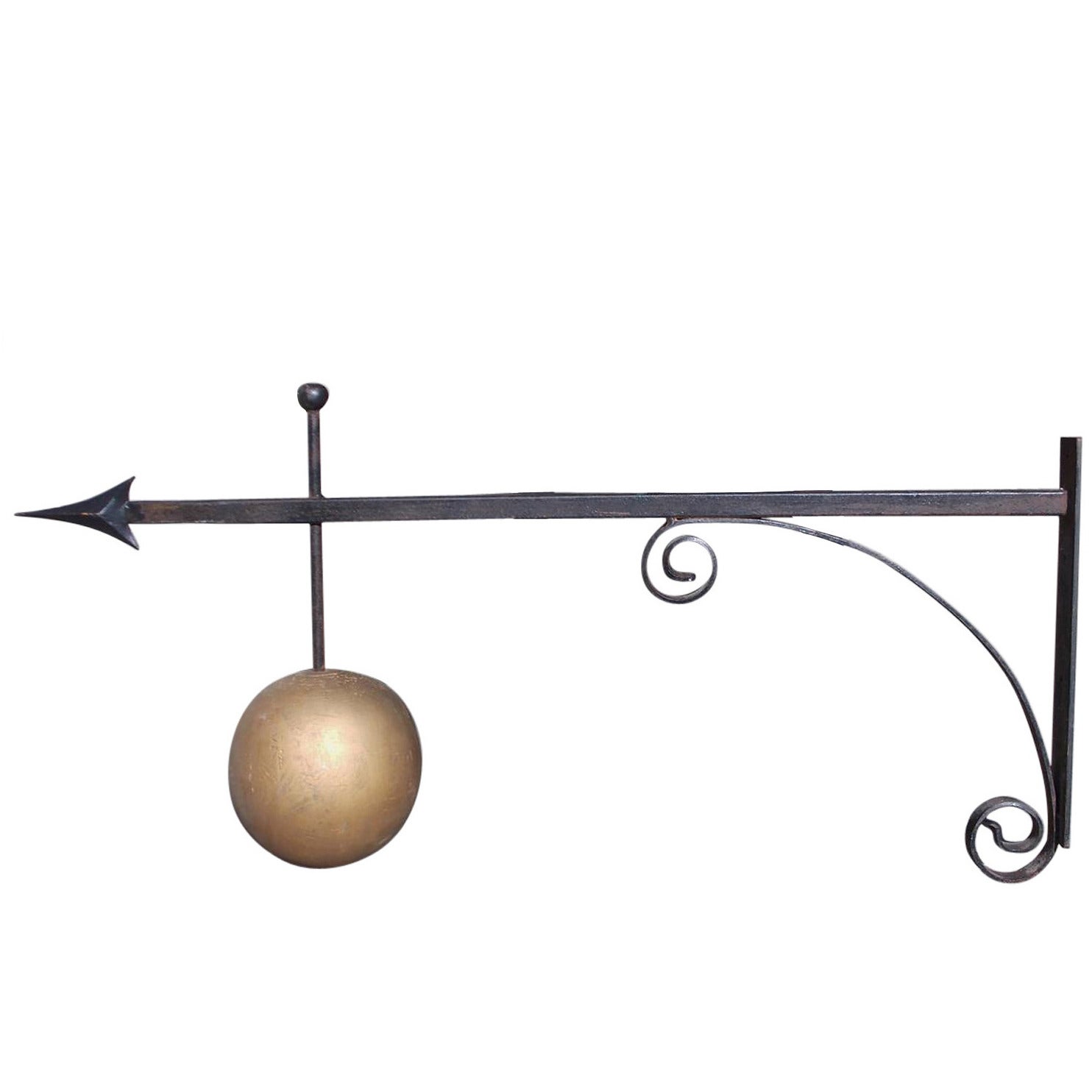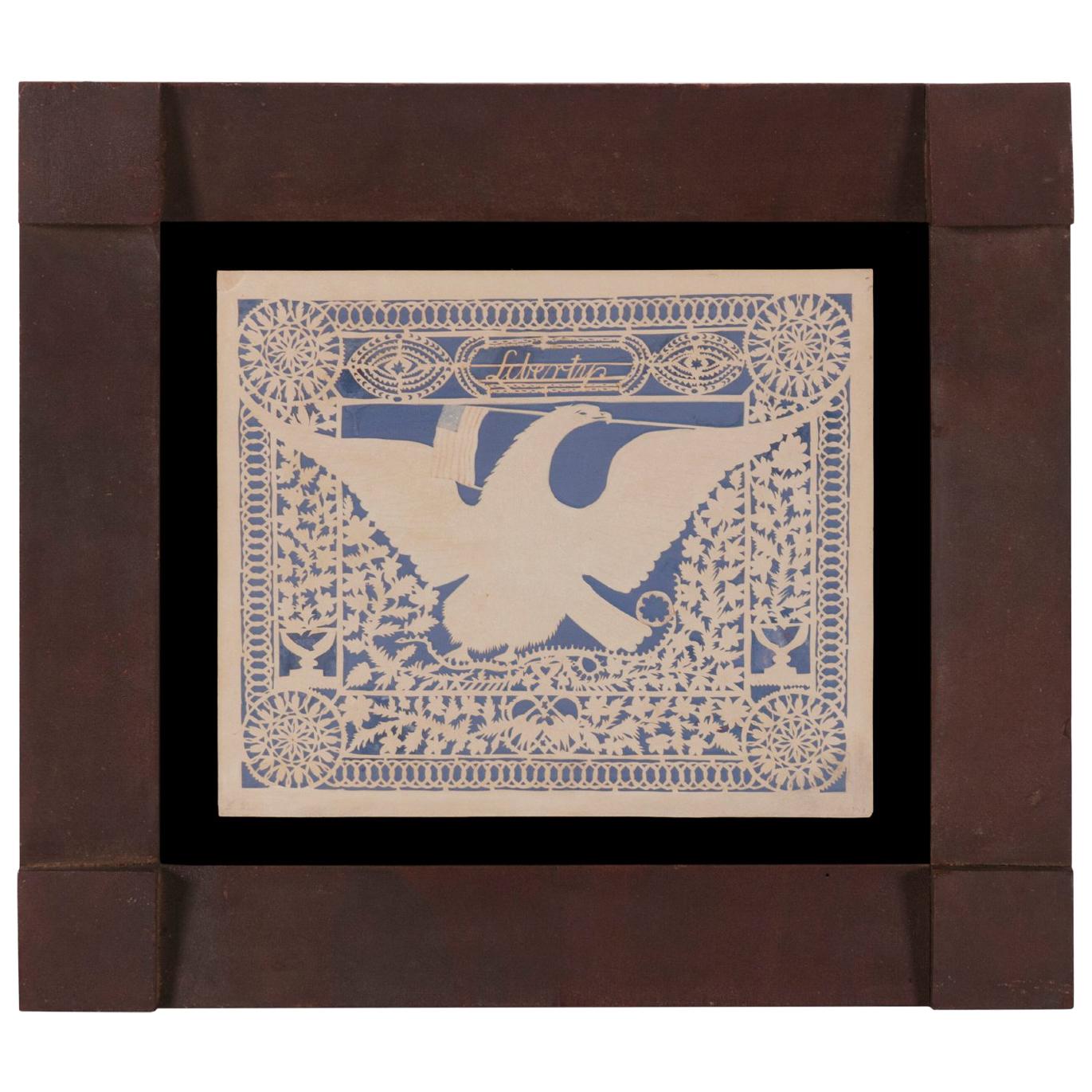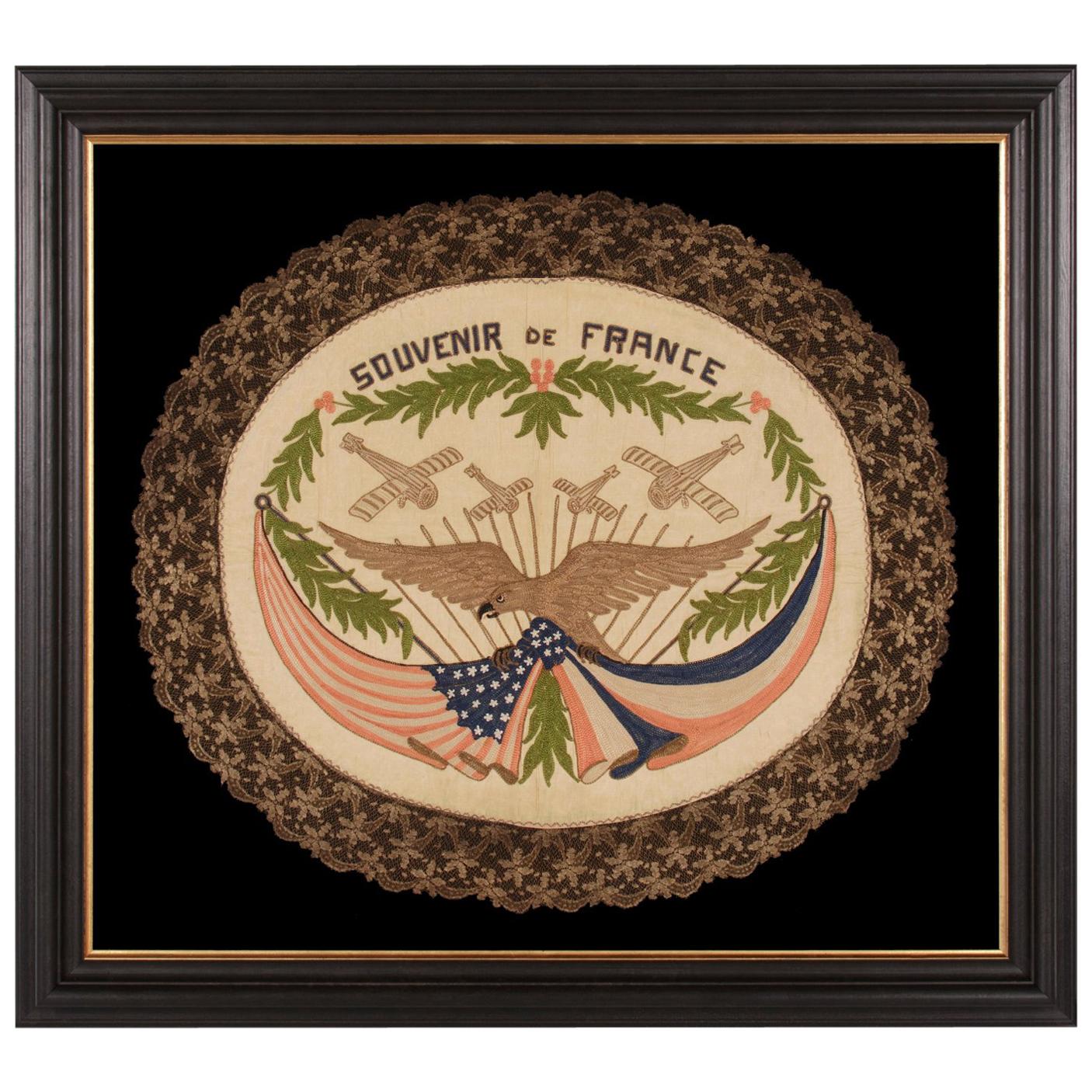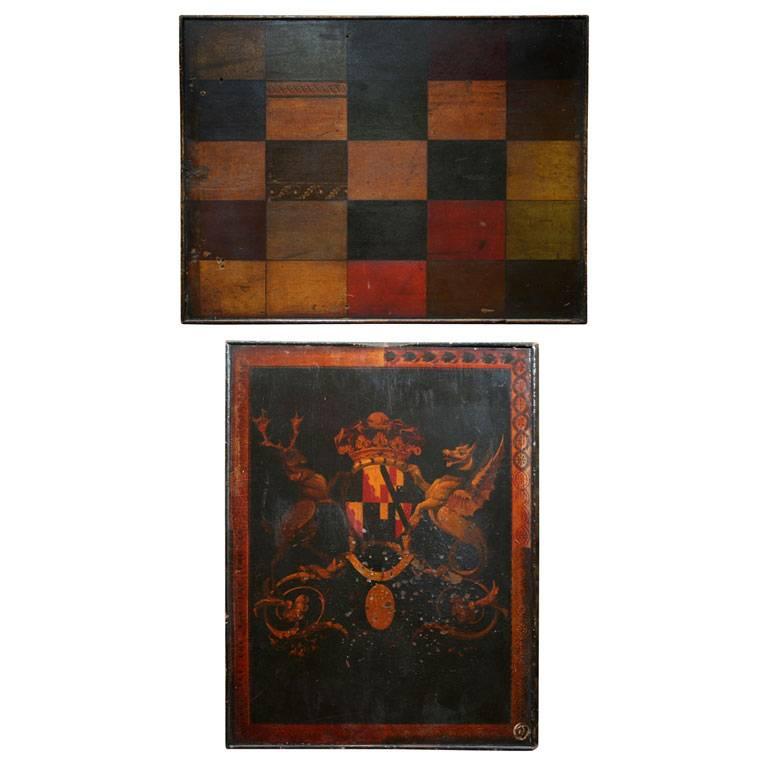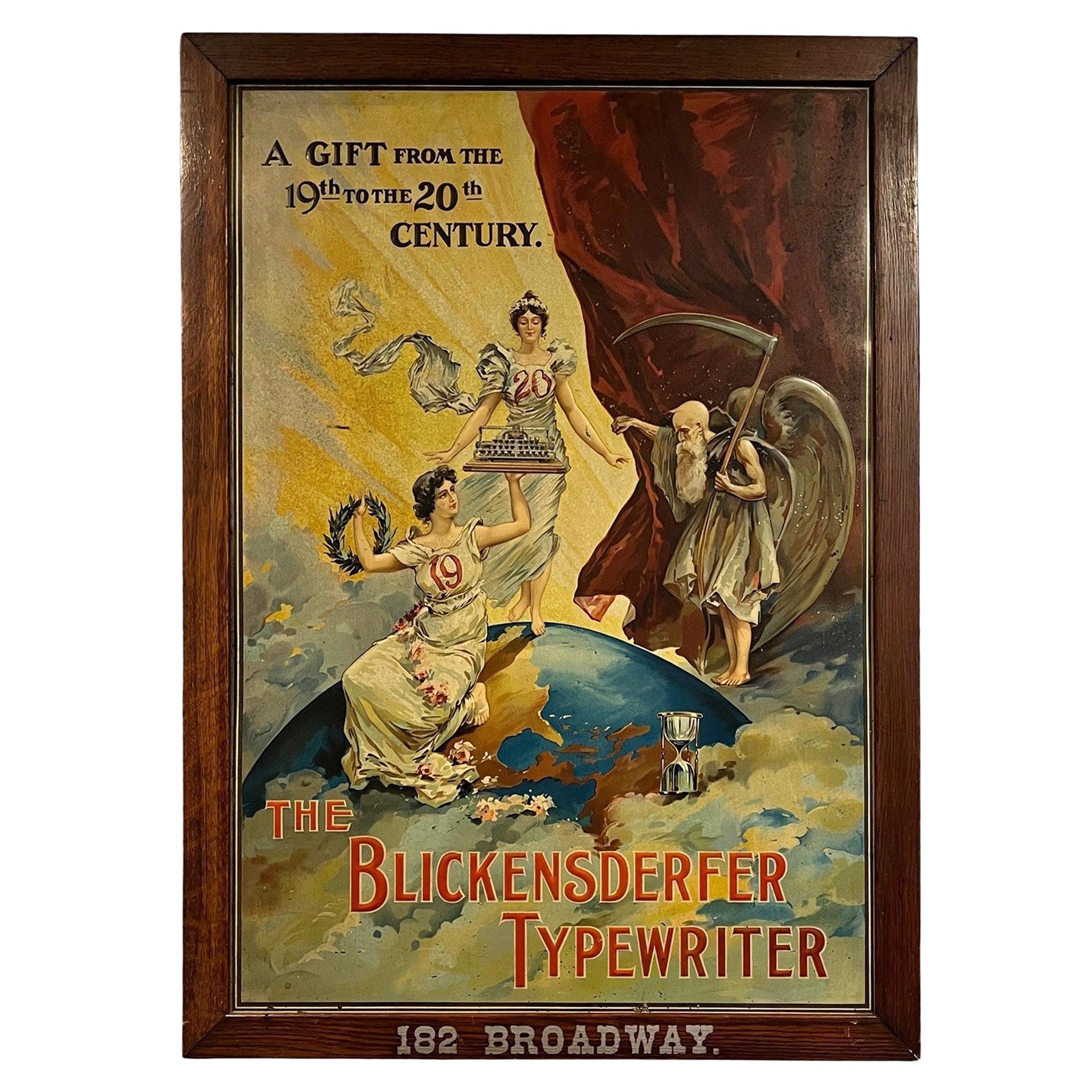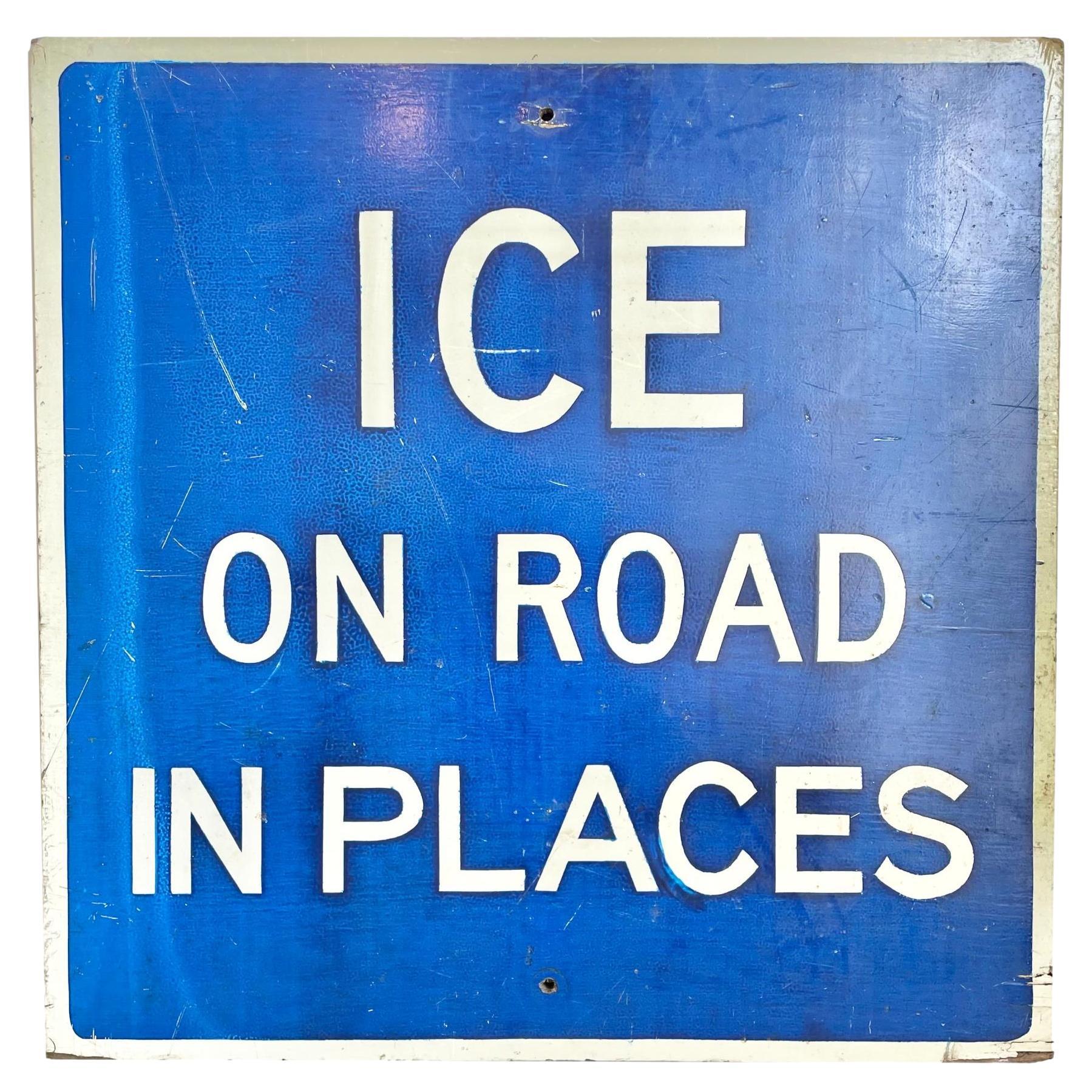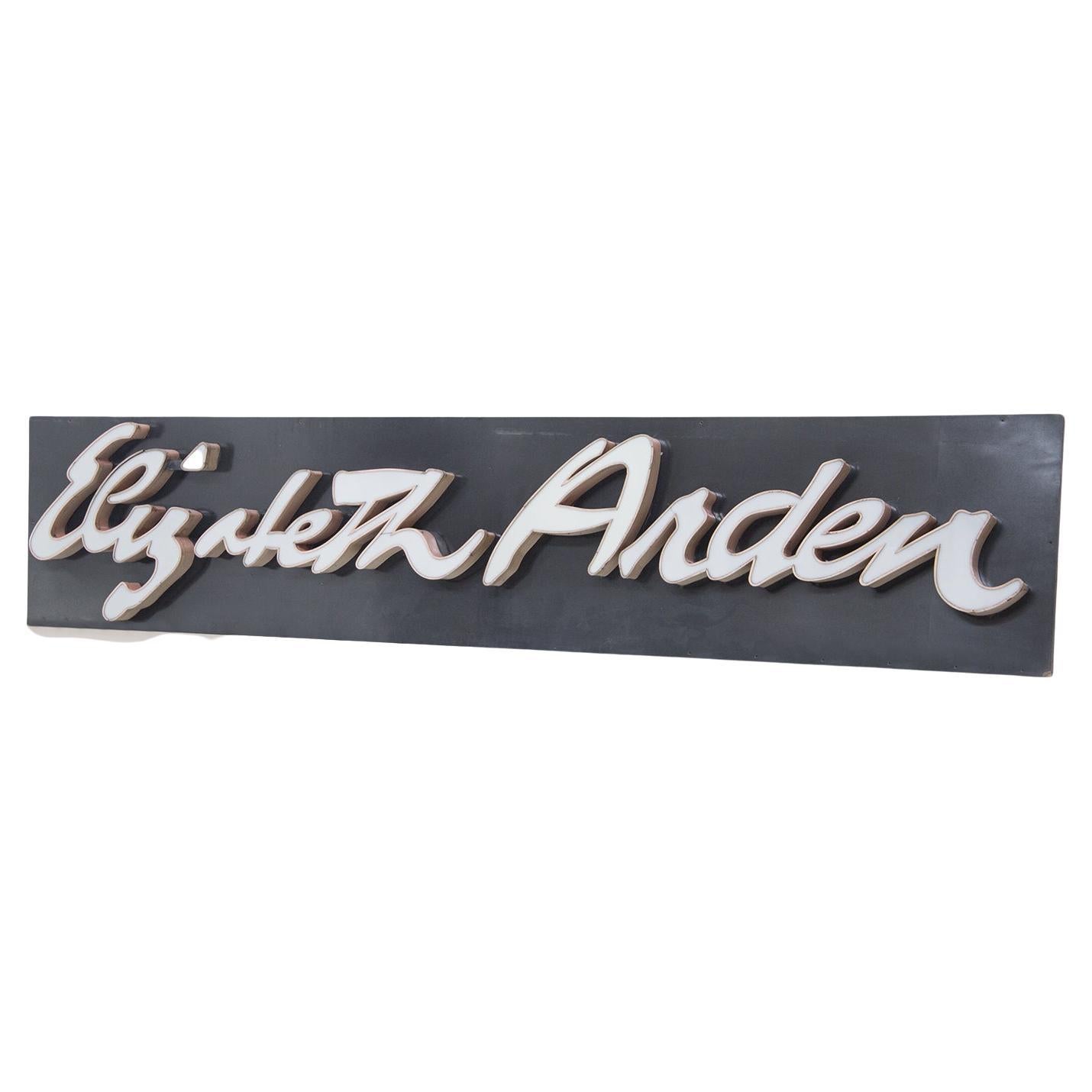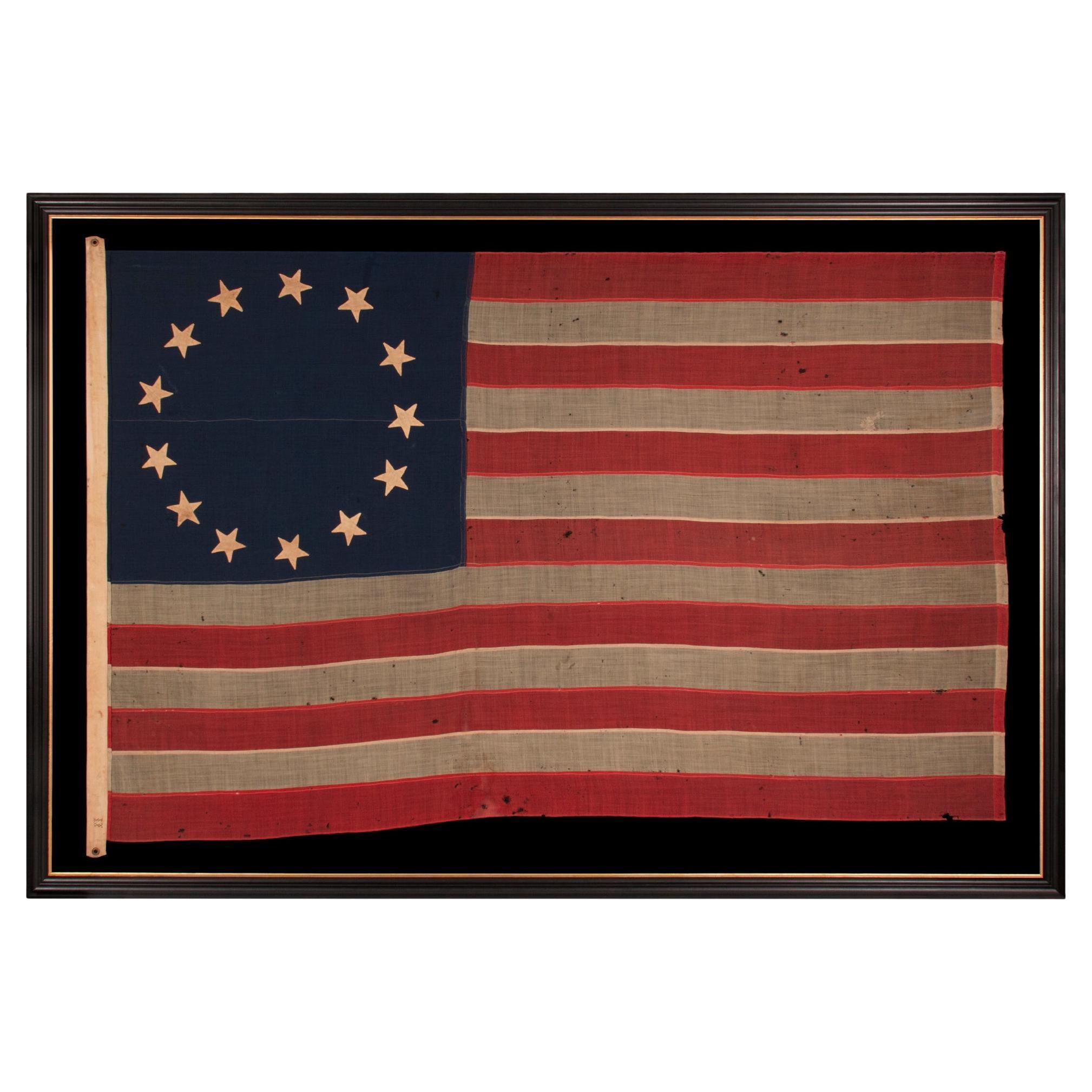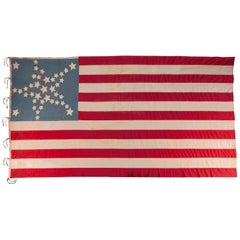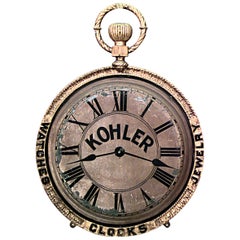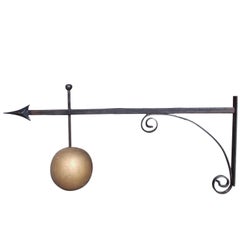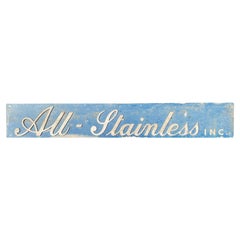
"All Honor To The Boys In Blue" Paint-Decorated American Sign, 1866-1880
View Similar Items
Want more images or videos?
Request additional images or videos from the seller
1 of 5
"All Honor To The Boys In Blue" Paint-Decorated American Sign, 1866-1880
About the Item
- Dimensions:Height: 26 in (66.04 cm)Width: 51.5 in (130.81 cm)Depth: 1.25 in (3.18 cm)
- Materials and Techniques:
- Place of Origin:
- Period:
- Date of Manufacture:1866-1880
- Condition:See Item Description.
- Seller Location:York County, PA
- Reference Number:Seller: sgn-0921stDibs: LU84975456933
About the Seller
5.0
Recognized Seller
These prestigious sellers are industry leaders and represent the highest echelon for item quality and design.
Established in 1991
1stDibs seller since 2008
60 sales on 1stDibs
Typical response time: 13 hours
More From This SellerView All
- Patriotic Scherenschnitte In the Style Often Attributed to Isaac StiehlyLocated in York County, PAEXCEPTIONAL PATRIOTIC SCHERENSCHNITTE (PAPER CUTTING), IN THE STYLE OFTEN ATTRIBUTED TO ISAAC STIEHLY, ENTITLED “LIBERTY,” WITH IMAGERY THAT INCLUDES AN AMERICAN EAGLE WITH A 14 STAR, 14 STRIPE FLAG IN ITS BEAK, A RATTLESNAKE, LOVE BIRDS, AND EAGLES ON URNS, CA 1830-1850 This exceptional patriotic scherenschnitte was executed in the style often attributed to Pennsylvania German minister Isaac Stiehly (1800-1869). Scholars now agree that one or more artists, working in New York, were producing their own work in a very similar style. Several examples are known that bear the names of New York and/or New Jersey residents, while two, in particular, include text that celebrates the 1844 New York mayoral election victory of publishing magnate James Harper [founder of what is now Harper Collins], who ran on a ticket sponsored by the American Republican Party, a nativist organization concerned with the loss of American jobs to Irish immigrants. Note the quality of the cutwork on this example, the centerpiece of which is a large American eagle, gripping a coiled rattlesnake and holding an American flag in its beak. Above, in a lozenge-shaped medallion, the word "Liberty" is executed in large script. To the left and right of this are elaborately decorated ovals, and anchoring each corner of the work are snowflake-like medallions. To each side of the eagle, and below, is a plethora of flora and fauna, the outermost pillars of which are supported by two urns, decorated with eagles. At the bottom center is a diamond within a heart, with two doves, one of which is offering the other a leaf. Above this there are appear to be crude representations of a gnome and a fairy flanking and urn decorated with another heart, from which grow the vines in the center window. Interlocking rings decorate the border, probably to represent marriage, and it can logically be presumed that the scherenschnitte was a wedding gift. It is of interest to note that the flag displays both 14 stars and 14 stripes. Although the reason for the use of this count is unknown, on the surface it does appear to be intentional. Other known patriotic scherenschnitte display flags with various star and stripe counts. Of those I have personally owned, the one bore 14 stars and 13 stripes, another 11 stars and 13 stripes, another displayed two flags, including a 12 star flag with 14 stripes and a 14 star jack (a blue naval flag with stars but no stripes), and another, also with 2 flags, displayed a 20 star flag...Category
Antique Mid-19th Century American Political and Patriotic Memorabilia
MaterialsPaper
Price Upon Request - Franco-American Textile with the Image of an Eagle Holding the American and FlagLocated in York County, PAFranco-American textile with the image of an eagle supporting knotted and draped american and French flags beneath four war planes; embroidered silk floss and metallic bullion thread...Category
Mid-20th Century American Political and Patriotic Memorabilia
MaterialsSilk
- 34 Star American flag, Updated to 39 Stars, with Stars in a Great Star PatternLocated in York County, PA34 STARS IN A WHIMSICAL RENDITION OF THE GREAT STAR PATTERN, ON A CIVIL WAR PERIOD FLAG WITH A CORNFLOWER BLUE CANTON, UPDATED TO 39 STARS IN 1876 34 star American national flag with additional stars added and one of the most stunning graphic designs I have ever seen in early flag-making. The original pattern was comprised of a circle of 5 large stars, and triangular arms made of smaller stars. These are noticeable pointy and bent like the arms of a starfish. Made of cotton, the stars are hand-sewn and double-appliquéd to a fantastic, cornflower blue canton, a color common to Civil War uniforms...Category
Antique 1870s American Political and Patriotic Memorabilia
MaterialsCotton
- 13 Star Antique American Flag in the Betsy Ross Pattern, ca 1861-1865Located in York County, PA13 star antique American flag in the Betsy Ross pattern, one of just three examples that I have encountered that pre-date the 1890’s; an extraordinary find, civil war period (1861-1865) or just after, extremely large among its counterparts of all periods in this design: Exceptional, early, American national flag, with 13 stars arranged in the circular wreath pattern most often attributed to Betsy Ross. Since there was no official configuration for the stars of the American flag until 1912, when our nation received its 47th and 48th states, the design, before that time, was left to the whims of the maker. This led to an almost unimaginable spectrum of star arrangements on the American flag during the 18th and 19th centuries. Even within the 13 star count, alone, there are at least 80 known patterns—more than the average person would even think possible. 13 star flags have been made throughout American history, from at least June 14th, 1777, when the first Flag Act was passed by Congress, until the present. They have been continuously produced for reasons both patriotic and utilitarian. Because this was the original number of stars on the American flag, representing the 13 colonies, it was appropriate for any device made in conjunction with celebrations or notions of American independence. 13 star flags were thus displayed at patriotic events, including, but certainly not limited to, such occasions as Lafayette’s final visit, in 1825-26, the nation’s centennial in 1876, and longstanding celebrations of Independence Day. From at least 1840 onward, 13 star flags were produced for presidential campaigns, drawing a parallel between the past and present struggles for freedom, and were carried by soldiers, during the Mexican and Civil Wars, for the same purpose. Throughout history, and even today, they are boldly displayed at every presidential inauguration. 13 star flags were flown by American ships both private and federal. The U.S. Navy used 13 stars on the ensigns made for small boats, because they wished the stars to be more easily discernable at a distance. Private ships often copied Navy practice, and when commercial flag makers first began to produce flags with pieced-and-sewn construction, in small sizes, in large quantity, they frequently employed the 13 star count. Flags in the Betsy Ross design are widely admired, due to the longstanding popularity of the Ross family myth. While many Americans learned in grammar school that Betsy Ross made and designed our first flag, and that the stars appeared in a circular fashion, there is, unfortunately, no way to prove the claim. No colonial examples have survived with this pattern of stars. In fact, while arranging the stars in a single circle seems quite logical, among the various choices that might come to mind, early American flags with this star pattern are curiously absent. One of the interesting misconceptions about 13 star flags is that the Betsy Ross pattern, even if not the original design, must have been common in early America. Logic would suggest this, given the frequency with which it appears in modern times, but this isn’t actually the case. In fact, the pattern is seldom encountered anywhere until much later. In more than 30 years of buying and selling early Americana, and over 20 years of extensive focus on the American flag specifically, through aggressively buying, researching, evaluating, restoring, and curating exhibitions, I have thus far encountered just three examples of Betsy Ross pattern flags that I can confidently date prior to the 1890's. No one knows what the first flag looked like. While there is no precise reason that the Betsy Ross design could not have been the first, one of the best arguments against it, is illustrated by the simple fact that so many 13 star flags exist without it. If the Ross configuration was the original, it stands to reason that the pattern would have been reproduced with at least some degree of frequency. Research conducted by the National Museum of American History notes that the story of Betsy Ross making the very first American flag for General George Washington, in the company of George Ross and Robert Morris, entered into American consciousness about the time of the 1876 centennial. The tale was immensely popular among an American public eager for stories about the Revolution and its heroes. The first documentation of it appeared shortly beforehand, in 1870, in a paper written by Betsy’s grandson, William Canby, for the Pennsylvania Historical Society. At the time, Canby made no mention of how the flag was designed, save for the fact that it had 5-pointed stars, per his grandmother’s suggestion. Because no earlier documentation supports the story, most flag scholars feel it was a grand hoax, fabricated by Canby for his own interests. Nothing survives in the collective writings of the three men, for example, nor in records of their words and deeds, which are fairly extensive. As with most things, reality is perhaps somewhere in the middle ground, with some of the details based on fact and some on fiction, made up, misinterpreted, or imagined from family accounts. The first time that a star configuration gets attached to the Ross story appears to have occurred during the last decade of the 19th century. In 1892, Charles Weisgerber painted a nine-by-twelve-foot rendition of the fabled meeting between Betsy and George Washington, in which there is a flag with a circular wreath. Shortly afterwards, in 1898, Betsy’s granddaughter and great-granddaughter began to make flags in the East Wing of Independence Hall in Philadelphia, selling them to tourists while disseminating the family folk tale. In that same year, Weisgerber and a “group of concerned citizens” sought to preserve Betsy’s former Philadelphia residence at 239 Arch Street, where she lived at the time the flag would have been sewed. Weisgerber moved his family into the house and immediately opened to the public the room in which Betsy was said to have worked her magic. Ten-cent memberships were sold to fund renovations and donors received a small calendar, to which a cotton 13 star Betsy Ross pattern parade flag was affixed. The effects of these events caused the Ross legend to stick and the story, with the corresponding flag design, has appeared ever since in more places than one could ever hope to count. The stars of this particular flag are made of cotton, hand-sewn, and double-appliquéd (applied to both sides). The canton and stripes of the flag are made of wool bunting that has been pieced and joined with treadle stitching. There is a sailcloth canvas binding along the hoist, with two brass grommets, one each at the extreme top and bottom. Along this, on the obverse, near the bottom, are two, unusual characters, embroidered with brown thread. These may be letter “I’s,” possibly forming a the Roman Numeral “II.” They are followed by an inscription, in blue ink, that appears to read “A. N. Smith.” The first character is stylized, and may alternatively be a “D,” “H,” or perhaps a “J.” Note how the binding is extended beyond the top and bottom-most points. Though quite unusual, this is sometimes encountered in early examples. The folding of the wool bunting back onto itself, with the binding stitched so that part of the fold is exposed, tends to be an early characteristic. Common in Civil war flags...Category
Antique 1860s American Political and Patriotic Memorabilia
MaterialsCotton
Price Upon Request - 13 Star American Flag with Hand-Sewn Stars in the 3rd Maryland PatternLocated in York County, PA13 hand sewn stars in a circular version of what is known as the 3rd Maryland pattern, with an especially large center star, a flag with especially tiny scale among those with pieced-and-sewn construction, exceptionally rare, made circa 1890: 13 star flags have been flown throughout our nation’s history for a variety of purposes. They were hoisted at patriotic events, including Lafayette’s visit in 1824-25, the celebration of the centennial of American independence in 1876, and the sesquicentennial in 1926. They were displayed during the Civil War, to reference past struggles for American liberty and victory over oppression, and were used by 19th century politicians while campaigning for the same reason. As the number of stars grew with the addition of new states, it became more and more difficult to fit their full complement on a small flag. The stars would, by necessity, have to become smaller, which made it more and more difficult to view them from a distance as individual objects. The fear was that too many of them close together would become as one white mass and distort the ability to identify American ships on the open seas. Keeping the count low allowed for better visibility. For this reason the U.S. Navy flew 13 star flags on small boats. Some private ship owners mirrored this practice and flew 13 star flags during the same period as the Navy. Flag experts disagree about the precisely when the Navy began to revert to 13 stars and other low counts. Some feel that the use of 13 star flags never stopped, which seems to be supported by depictions of ships in period artwork. This was, of course, the original number of stars on the first American national flag, by way of the First Flag Act of 1777, and equal to the number of original colonies that became states. Any American flag that has previously been official remains so according to the flag acts, so it remains perfectly acceptable to fly 13 star flags today by way of congressional law. Since there was no official star configuration until the 20th century (1912 specifically, beginning with the 48 star count), the stars on 13 star flags may appear in any one of a host of configurations. Some of these are more rare and desirable than others. The stars of this particular flag are arranged in what has come to be known as the "3rd Maryland Pattern." This configuration, whether oval or circular, is appreciated both for its visual appeal and the scarcity of its use. a circular wreath of 12 with a single star in the center. The name comes from a flag that resides at the Maryland State Capitol in Annapolis, long thought to have been present with General Daniel Morgan at the Battle of Cowpens in 1781. According to legend, the flag was supposed to have been carried by Color Sergeant William Batchelor of the 3rd Maryland Light Infantry and was donated to the State of Maryland by Batchelor's descendants. The story was disproved in the 1970's, however, following an examination by the late flag expert Grace Rogers Cooper of the Smithsonian, who discovered that the Cowpens flag was, at the earliest, of Mexican War...Category
Antique 1890s American Political and Patriotic Memorabilia
MaterialsWool
Price Upon Request - Antique American Flag w/ 13 Stars in the Betsy Ross Design & 45 Stars on ReverseLocated in York County, PA13 STARS IN THE BETSY ROSS PATTERN, WITH 45 STARS ON THE REVERSE; ON AN ANTIQUE AMERICAN FLAG MADE AND SIGNED BY A PREVIOUSLY UNIDENTIFIED FLAG-MAKER, ANNIE MAC LACHLAN OF JERSEY CI...Category
Antique 1890s American Other Political and Patriotic Memorabilia
MaterialsWool, Cotton
You May Also Like
- American Country Tole Painted Clock Makers SignLocated in New York, NYAmerican Country (19th Century) tole painted and gold trimmed double faced pocket watch clock makers sign.Category
Antique 19th Century American Country Signs
MaterialsTin
- American Wrought Iron and Gilt Trade Sign Bracket , Circa 1880Located in Hollywood, SCAmerican wrought iron and gilt trade sign bracket with decorative scroll work and gilt ball motif. Late 19th CenturyCategory
Antique 1880s American Folk Art Signs
- 1950's Commercial Sign "All - Stainless Inc"Located in Hanover, MAVintage commercial business sign from early 1950's for All - Stainless, Inc. 78" long by 12" high panel of patinated blue colored aluminum with 1/4" th...Category
Vintage 1950s American Industrial Signs
MaterialsAluminum
- Folk Art Sign-Maker's Sample Board in Original PaintLocated in Greenwich, CTA Folk Art two-sided sign maker's sample board in original paint, one side having square color samples with various border treatments, each panel numbered (one through 25), the other...Category
Antique Late 18th Century English Folk Art Decorative Art
MaterialsWood
- Blickensderfer Typewriter Tin Sign "A Gift from the 19th to the 20th Century"Located in Stamford, CTA Wonderful Blickensderfer Typewriter Advertising Sign " A GIFT from the 19th to the 20th CENTURY " ( circa 1899 ) simply an amazing sign. The tin sign is in a wood frame with the ad...Category
Antique Late 19th Century American Signs
MaterialsTin
- Hand Painted 'ICE ON ROAD IN PLACES' Wooden SignLocated in Los Angeles, CAGreat vintage wood sign from the 1980s. Hand-painted. Deep blue background with white lettering and white border. Very good vintage condition. Perfect for a cabin or winter house...Category
Vintage 1980s American Signs
MaterialsWood, Paint

